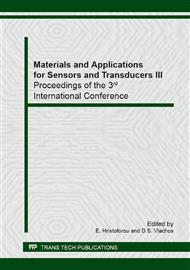[1]
L. Alfonta, O. Bukelman, S.A. Cruz-Jimenez, D. Fink, G.M. Hernandéz, V. Hnatowicz, I. Klinkovich, V. Havranek, J. Vacík , Nuclear Biotechnology. Invited talk, presented at the E-MRS Strassbourg, France, 26.-31.5.2013. Nucl. Instr. Meth. B, in print (2014)
Google Scholar
[2]
Fink, D.; Klinkovich, I.; Bukelman, O.; Marks, R.S.; Kiv, A.; Fuks, D.; Fahrner, W.R.; Alfonta, L. Glucose determination using a re-usable ion track membrane sensor. Biosens: Bioelectron. 2009, 24, 2702-2706.
DOI: 10.1016/j.bios.2008.12.001
Google Scholar
[3]
D. Fink, G. Muñoz H., L. Alfonta, Highly Sensitive Ion Track-Based Urea Sensing with ion-irradiated polymer foils, Nucl. Instr. Meth. B 273(2012) 164–170.
DOI: 10.1016/j.nimb.2011.07.066
Google Scholar
[4]
H. García Arellano, D. Fink, G. Muñoz Hernández, L. Alfonta, Nuclear track-based biosensors with the enzyme laccase. Proc. SSMIB, Kusadaši, Turkey, Sept. 15-20, (2013)
DOI: 10.1016/j.apsusc.2014.03.074
Google Scholar
[5]
D. Fink, J. Vacik, L. Alfonta, A. Kiv, Y. Mandabi, G. Muñoz H., Optimization of transport processes in etched track-based biosensors. Radiation Effects & Defects in Solids 167 2011, 1029-4953.
DOI: 10.1080/10420150.2011.647914
Google Scholar
[6]
G. Muñoz H., S.A. Cruz, R. Quintero, H. García A., D. Fink, L. Alfonta, Y. Mandabi, A. Kiv, J. Vacik, Coupled chemical reactions in dynamic nanometric confinement: Ag2O membrane formation during ion track etching. Radiat. Eff. Def. Solids 2013, 168, in print.
DOI: 10.1080/10420150.2012.748764
Google Scholar
[7]
D. Fink, G. Muñoz H., N.L. Ruiz, S.A. Cruz, J. Vacik, L. Alfonta, Y. Mandabi, A. Kiv, Coupled Chemical reactions in dynamic nanometric confinement V: The influence of Li+ and F- on etching of nuclear tracks in polymers. Radiat. Eff. Def. Solids, in print (2014)
DOI: 10.1080/10420150.2014.880840
Google Scholar
[8]
D. Fink, W.R. Fahrner, K. Hoppe, G. Muñoz H., H. García Arellano, A. Kiv, J. Vacik, L. Alfonta, Coupled chemical reactions in dynamic nanometric confinement: III. Electronic Characterization of Ag2O membranes within etched tracks and of their precursor structures. To be published in: "Trends in real world sensing and integrated micro sensors"; K. Iniewski and K. Yallup Eds., CRC Press Boca Raton, Florida, (2013)
DOI: 10.1201/b16746-10
Google Scholar


